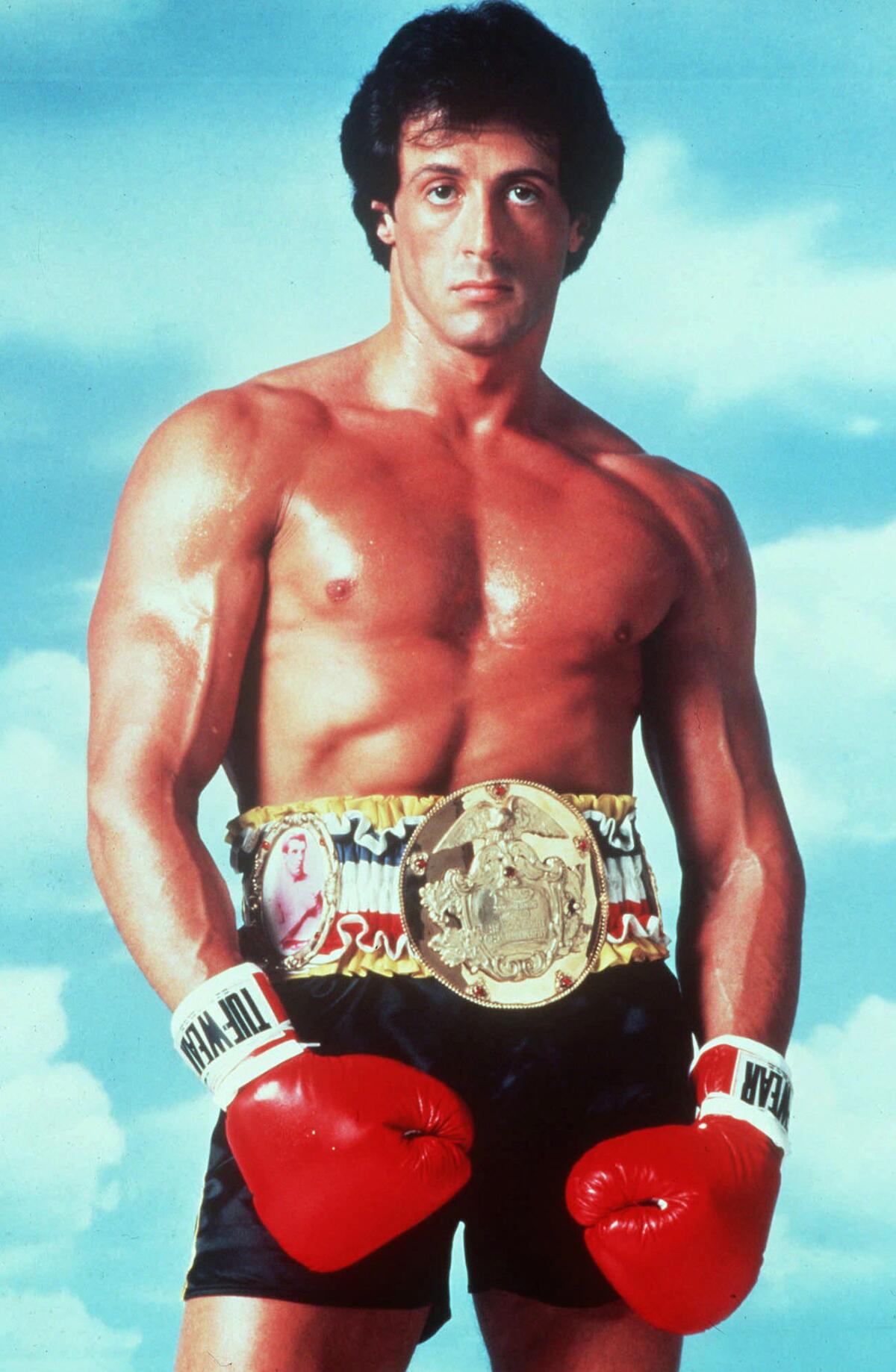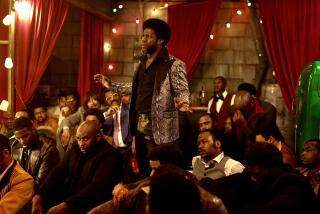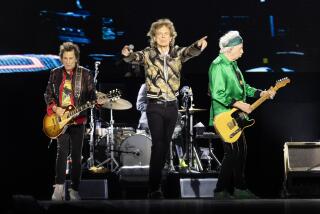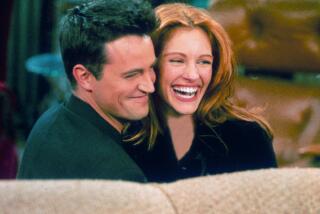From the Archives: ‘Rocky’ hits right on the button

Grapevines can be skillfully nourished, if there is something genuinely worth talking about, and as long ago as midyear the escalating word of mouth out of carefully cast private screenings was that a little movie called “Rocky” was very, very special.
And so, by all that makes movies movies, it absolutely is. In one warming stroke it revives and restores the vital tradition of the low-cost and unpretentious movie which creates stars instead of hiring them and which commandeers the rousing affection of its audiences by proclaiming the possibility of love, hope and triumph in the lives of ordinary men and women (who are anything but ordinary in their sympathetic individuality).
“Rocky,” opening on Wednesday, was written by and stars Sylvester (Sly) Stallone, a sturdy young actor previously remembered as a costar with Henry (The Fonz) Winkler in “The Lords of Flatbush,” another low-budget and less-heralded film, shot in 16mm, which became a large critical and commercial hit. Stallone is now and forever more a name and talent to conjure with.
His Rocky is part Marty, part the Brando of “On the Waterfront,” a lumbering nice-guy loner who lives in a really crummy apartment with a goldfish, a pair of turtles named Cuff and Link and a poster of Marciano. He makes small change as a strong but awkward club fighter ($42 net for a win) and earns his keep as a collector for a flashy waterfront loan shark (Joe Spinell). He is a strong but lousy collector, too good-hearted to deliver overdue notices in the form of broken fingers and arms.
He has eyes for the chronically shy and repressed clerk (Talia Shire), who works in a pet shop and is the sister of his beefy and beefing pal (Burt Young) going lame and alcoholic among the cold carcasses in a packing plant.
The simple plot of Stallone’s working-class fairy tale is that Rocky, as the patsy in a promotion stunt, gets a shot at the heavyweight title held by a tycoon in trunks here called Apollo Creed but satirically modeled, in all his extravagant and lucrative showmanship, on Muhammad Ali.
In its straight-line development, in parallel, of the love story and the big fight, “Rocky” seems wonderfully guileless, but it is the innocence won of an artful sophistication crafty enough to conceal itself. The director was John G. Avildsen who, off of “Cry Uncle,” “Joe” and “Save the Tiger,” has learned how to do much with little and how to catch the sights, sounds and feelings, almost the aromas, of life as it is ordinarily lived in real places.
“Rocky” seems as brilliantly orchestrated as a fine if raucous symphony, alternating tumults and solitudes, humor (Rocky is a joke maker, usually intentionally, as Marty and the Brando character weren’t), anger, small rejections and small victories, building to an ending which is surprising, ingenious, logical and blissfully pleasing.
(At the two screenings I have attended, “Rocky” got roaring, sustained standing ovations the likes of which I can’t remember hearing at a movie before.)
The establishing of Rocky’s life-style and his world, Philadelphia at its scruffiest, is daringly careful, deliberate and meticulous: a slugfest in the local church arena, the squalor of the dressing room, the bruised walk home down streets that are not mean but terminal, the monologue in his rooms, being deprived of his gym locker in favor of a more promising fighter, a chewing out from the shark and his taunting bodyguard-driver (Joe Sorbello).
But the birth of love, in its comedic way, is lyrically affecting. The first date, on an ice-skating rink deserted on Thanksgiving night, is one of those indelible movie sequences. (It is also a product in part of a fortunate necessity. The budget did not allow for the extras the script called for, but the scene works much better with the rink empty.)
The girl takes off her glasses and — it was ever so — is seen to be most tenderly beautiful. Talia Shire, twice nominated for Oscars before, is one of the film’s several contenders this time, for her intelligent, sensitive and touching performance.
Rocky’s training, revealing Stallone’s own grueling five-month preparation for the part, is fascinating to watch. Thanks to a newly developed body-held camera, cinematographer James Crabe was able (without impossibly costly tracking platforms) to follow Stallone jogging before dawn through all of Philadelphia, a literal opening up which appropriately symbolizes an opening up of Rocky’s world and his chances.
The exultant climax of the training regimen is another unforgettable moment which gets well-deserved applause.
One of the strengths of “Rocky” is the relative freshness and unfamiliarity of most of its cast. All are talented professionals with considerable lists of credits but you sense you are seeing them for the first time, as the characters they are intended to be, not as actors acting. The one very familiar face is Burgess Meredith’s, as the sour old manager of the gym, a former fighter for whom all the breaks have been bad, unless he can hitchhike on Rocky’s luck. It is a vivid characterization, recalling his failing salesman in “Day of the Locust.” But for its skill, it is still identifiable as a performance and the one element you would have wished changed for the purposes of the ensemble.
For the rest, highest honors for the art that does not show itself as art: Carl Weathers as the champ, realizing from Round 1 that he has taken on more than he can kid to the canvas, Burt Young as the brother who is dying inside and knows it, Thayer David as the fight promoter with a heart like the carbon steel vault or a bank, Spinell and Sorbello as the hoods.
Stallone’s own performance is a once-in-a-lifetime coming together of man and material. He makes Rocky colorful, not too bright (although both he and Ms. Shire brighten and blossom as events move forward — it is part of the pleasure of the fantasy) and altogether heroic and engrossing.
The film involves boxing but it is not truly about boxing. (“Rocky” does not attack the sport but it is not an endorsement either; it remains possible to hate the sport and love the picture.) It is much more generally about the redeeming and ennobling powers of real love and about the possibility of overcoming whatever is defeating in our fates or within ourselves. And how long, we may well ask, has it been since any movie — particularly a movie as credibly rooted in a grittily identifiable real world as this one — was saying anything like that?
The movie is hardly less a miracle story than the story it tells. Stallone, not overwhelmed with work, drafted his rough treatment and took it to a pal, Gene Kirkwood, who handily enough is a material-finder for the producing team of Erwin Winkler and Robert Chartoff. They elected to go ahead on a very tight budget (around $1.3 million only) and even guaranteed the completion money themselves, which is unheard of among producers. If the film had gone over budget, they would have been stuck personally.
But all the endings seem certain to be happy for everyone involved. The street-flavored music by Bill Conti is just right. Richard Halsey was the editor and the art direction by James H. Spencer may not make him Philadelphia’s Man of the Year but is first-rate. Kirkwood is credited as executive producer for Chartoff and Winkler.
“Rocky” will play at the Plaza in Westwood.
More to Read
Only good movies
Get the Indie Focus newsletter, Mark Olsen's weekly guide to the world of cinema.
You may occasionally receive promotional content from the Los Angeles Times.










